Use 'Print preview' to check the number of pages and printer settings.
Print functionality varies between browsers.
Printable page generated Thursday, 25 April 2024, 5:09 AM
Badges and quizzes
Badges and quizzes
By successfully studying this course and meeting the required completion criteria you can gain a digital badge. There are two badges available:
- The purple badge is for new migrants, refugees and asylum seekers and the learning outcomes refer to your reflections on your roles as well as what you have learned from the course.
- The crimson badge is appropriate if you work alongside or have a role in supporting learners. Here the learning outcomes refer to your knowledge and understanding of the experiences of new migrants, refugees and asylum seekers referred to in the course.
Some of you may wish to complete both sets of quizzes to gain both badges, particularly if you gained a badge as a learner and then moved on to supporting new arrivals to the UK and want to gain recognition of your understanding of others’ experiences reflecting on their transitions.


Figure 1 Course badges
What is a badge?
Badges are a means of digitally recognising certain skills and achievements acquired through informal study and are entirely optional. They do not carry any formal credit as they are not subject to the same rigour as formal assessment; nor are they proof that you have studied the full unit or course. They are a useful means of demonstrating participation and recognising informal learning.
If you’d like to read more about badges you will find more information on these websites:
- Open Badges – this information is provided by Mozilla, a leading provider of the open badges system
- Digital Badges – this information is provided by HASTAC (Humanities, Arts, Science and Technology Alliance and Collaboratory), a global community working to transform how we learn, particularly making use of technology
- Organisations across Scotland are working together to develop open badges – read about who is involved and how badges are developing on the RSC Scotland website.
How to gain a badge for studying Reflecting on Transitions
To achieve a badge for studying Reflecting on Transitions you need to be enrolled on this free course and meet the following badge criteria:
- agree to the appropriate badge trust statement, depending on whether you are a learner or front-line staff or a support worker
- read each session
- attempt quiz 1
- achieve 40% for quizzes 2–5.
Enrolling on the course
Please note that you need to be enrolled on this course.
To enrol you’ll need to create an Open University account.
- If you already have an account, just click on ‘Sign in to enrol’ and enter your user name and password. If you don’t have an account, create your new account here.
- Follow the instructions, and once you have finished registration by reaching the My Account page simply close the browser window or tab.
- Then refresh THIS page to update your status so you can enrol.
- The enrolment button is in the top right-hand corner.
You are now enrolled and ready to start the course and quizzes.
Badge trust statements
The OpenLearn Works non-accredited badging system relies on trust. We trust you to answer the questions in the unit drawing on your own skills and knowledge as we do not have formal exams or invigilation as part of the units and course. The badge trust statement asks you to agree that the answers you submit to course quizzes are your own work and that you will not share answers with other learners. The badge trust statements are within the introduction to Session 1.
How to complete the course quizzes
Guide to completing the quizzes
When you start a quiz you’ll see an information page that lists learning outcomes. Under this there is a statement reminding you that you can have only one attempt at submitting your answers to the quiz (except in quiz 1). You can have between 1 and 3 tries at each question within the quiz, and you can see the number of tries you have left at the top left corner of the question page.
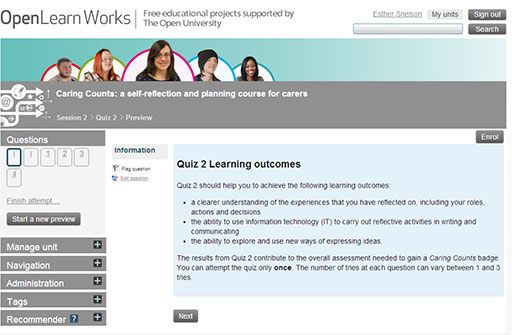
The next page is an explanation of how to find your way around the quizzes. You can click through to view questions without having to answer them, using the navigation panel on the left of the screen.
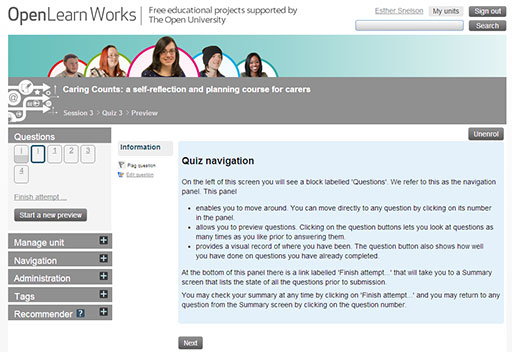
Each question starts on a new page and has instructions on how to tackle it. There are different types of question: choosing from a drop-down list as in the example below; dragging and dropping answers into boxes; and multiple-choice questions.
If you click on ‘Check’ you’ll be checking to see whether your answers are correct. Most questions will give you some feedback and, if you need to, suggest you try again up to the number of goes you’re allowed.
If you click on ‘Next’ you’ll move on to the next question. You can leave a question unanswered or partially answered and come back to it later. However, you’ll see that completing one question can help you tackle the next one.
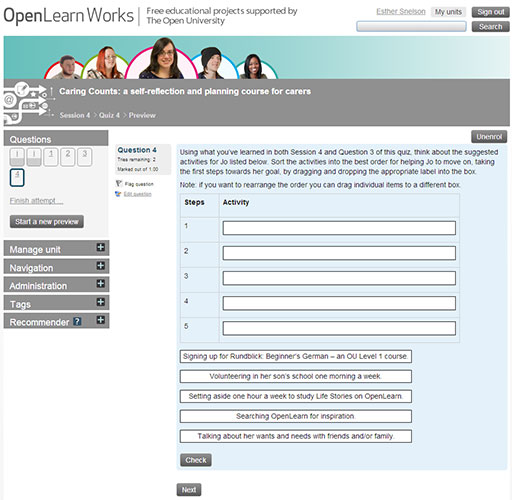
When you get to the final question, clicking on ‘Next’ brings up the quiz summary screen and an opportunity to submit your answers and complete the quiz for that session.
The Status column shows whether you’ve completed a question or whether you can have another go. You might not have completed all the questions, so you might want to go back and have another go.
The Marks column shows you how many marks you’ve achieved for each question so you can monitor your progress.
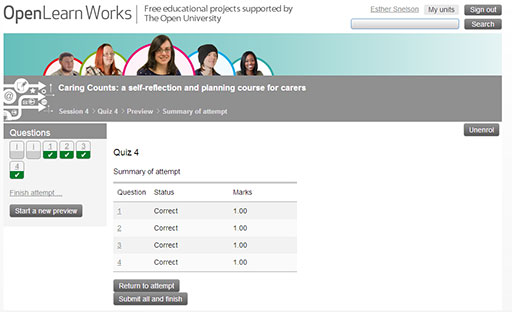
Once you’re happy that you’ve completed all the questions and/or used up all your goes you can click on ‘Submit all and finish’. You can only do this once for each of sessions 2–5, so it is important to be sure that you’ve done the best you can on each quiz.
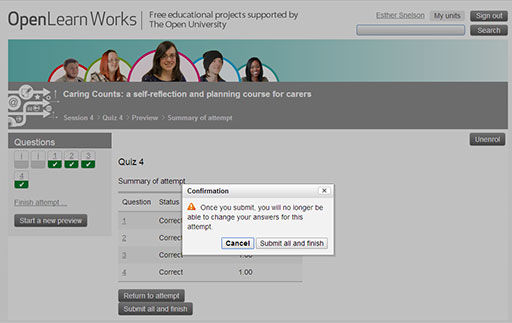
Once you’ve submitted your answers you’ll see a summary of your achievement in this quiz, which will indicate whether you’re on track to pass the course and gain your badge. Once you have reviewed your answers you should return to the course by clicking on the ‘return to Reflecting on Transitions’ link.
When you get to the end of the course and have successfully achieved the completion criteria your course badge will be issued.
How your Reflecting on Transitions badge is issued
When you have successfully achieved the completion criteria you will receive your Reflecting on Transitions badge. You will receive email notification that your badge has been awarded and it will appear in your My Badges area in your profile. Please note it can take up to 24 hours for a badge to be issued.


Figure 7 Reflecting on Transitions badges
To access your badge
From within the Reflecting on Transitions course:
Go to the navigation block and under My Profile you can access My Badges. When you click on My Badges you will be taken to your My Badges page on OpenLearn Works.

To view the details of your badge, and to download it or add it to your Mozzilla Backpack, click on the badge and you will be taken to the Badge information page.
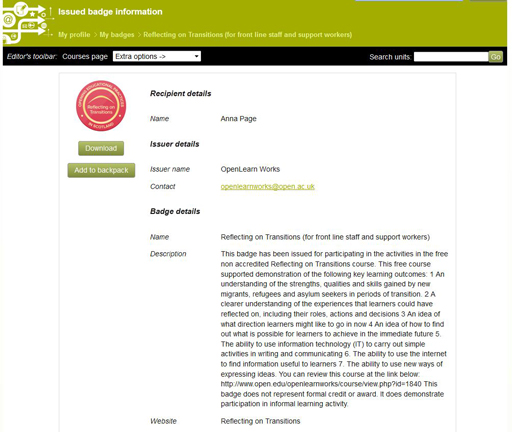
You can then either download this page to your computer or add the badge to your Mozilla Backpack.
What your Reflecting on Transitions badge will demonstrate
Learners
The purple badge shows that:
- you have gained an understanding of the process of reflection and personal planning
- you have achieved the learning outcomes listed below.
Front-line staff and support workers
The crimson badge shows that you have:
- gained knowledge and understanding of the experiences of new migrants, refugees and asylum seekers as referred to in the course
- a recognition and an understanding of the personal skills, qualities and abilities that can be gained by working through periods of transition
- achieved the learning outcomes listed below.
Learning outcomes
- An understanding of the strengths, qualities and skills gained by new migrants, refugees and asylum seekers during periods of transition
- A clearer understanding of the experiences that learners could have reflected on, including their roles, actions and decisions
- An idea of what direction learners might like to go in now
- An idea of how to find out what is possible for learners to achieve in the immediate future
- The ability to use information technology (IT) to carry out simple activities in writing and communicating
- The ability to use the internet to find information useful to learners
- The ability to use new ways of expressing ideas
The Reflecting on Transitions badges do not represent formal credit or award. Rather, they demonstrate successful participation in informal learning activity.
Sharing your badge
Badges awarded within OpenLearn Works can be shared via the Mozilla Backpack.
Downloading your badge to your Mozilla Backpack
You will need to create a Mozilla Backpack account.
When you have done this, click on the Add to backpack button and you will be asked to log into Mozilla if you have not already done so.
Follow the instructions on the screen and your badge should be automatically added to your backpack.
In the future we hope to be able to share our badges from OpenLearn Works to LinkedIn, Facebook and Twitter.
Acknowledgements
Reflecting on Transitions was developed by Lindsay Hewitt and Christine McConnell of The Open University in Scotland in collaboration with Bridges Programmes. The optional quizzes for the related digital course badges for learners and support workers, respectively, were developed by Julie Robson (The Open University) and Jonathan Sharp (Bridges Programmes). The course was edited by Lindsay Hewitt and Jennifer Nockles (The Open University).
We are hugely grateful to Bridges’ clients, Mo, Ying, Eric and Natalia, whose stories have informed the development of this course and bring to life the activities within it. We hope you find something in their experiences that speaks to you as well.
Except for third party materials and otherwise stated (see terms and conditions), this content is made available under a Creative Commons Attribution-NonCommercial-ShareAlike 4.0 Licence.
The material acknowledged below is Proprietary and used under licence (not subject to Creative Commons Licence). Grateful acknowledgement is made to the following sources for permission to reproduce material in this unit:
Every effort has been made to contact copyright owners. If any have been inadvertently overlooked, the publishers will be pleased to make the necessary arrangements at the first opportunity.
Don’t miss out:
1. Join over 200,000 students, currently studying with The Open University – http://www.open.ac.uk/ choose/ ou/ open-content
2. Enjoyed this? Find out more about this topic or browse all our free course materials on OpenLearn – http://www.open.edu/ openlearn/
3. Outside the UK? We have students in over a hundred countries studying online qualifications – http://www.openuniversity.edu/ – including an MBA at our triple accredited Business School.